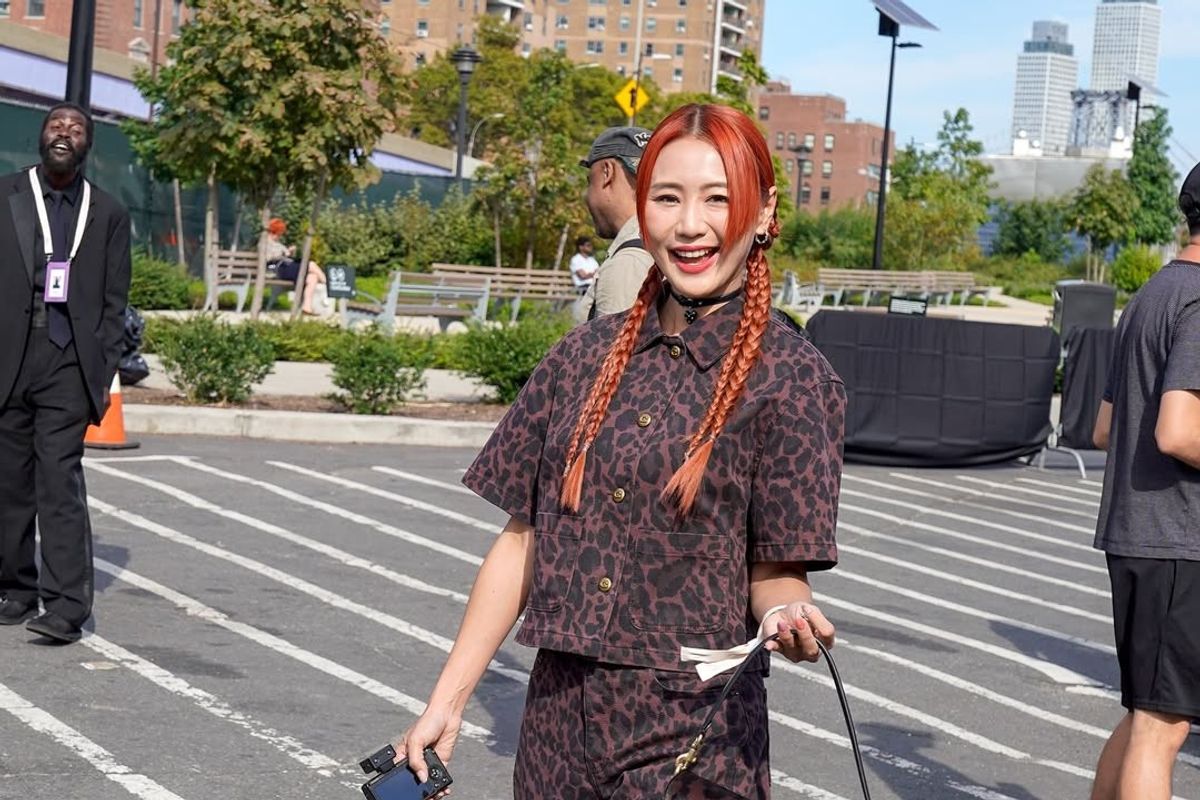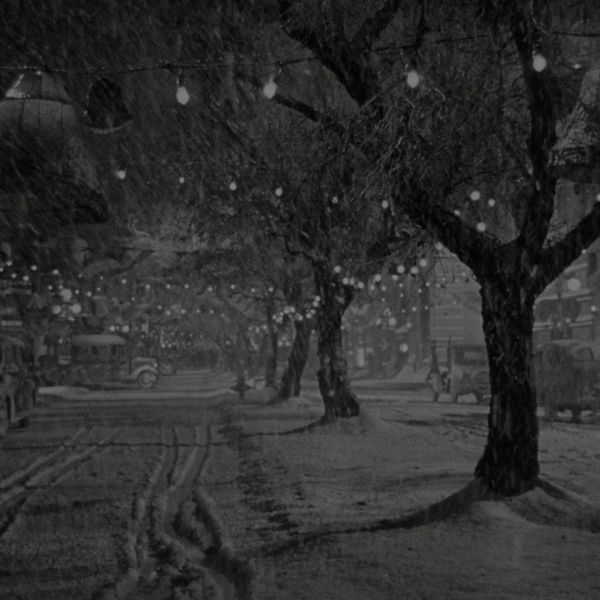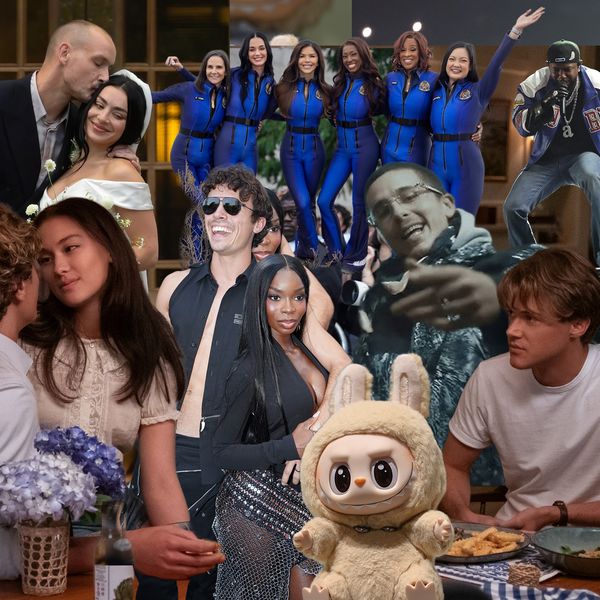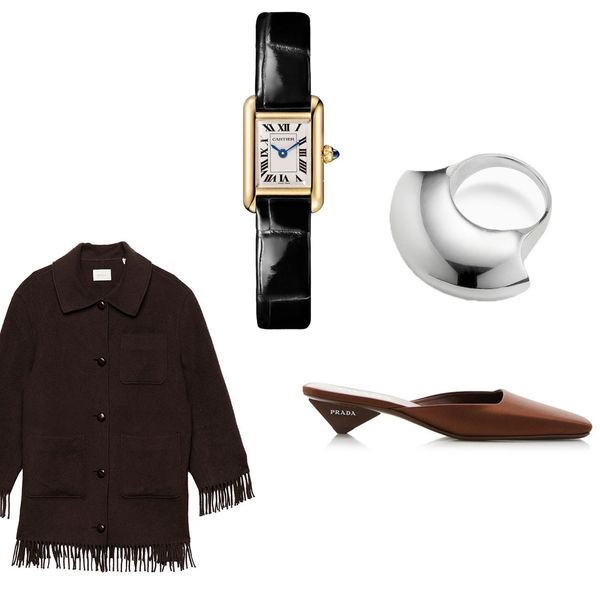So You Want To Be A Fashion Week Photographer
Three seasoned pros break down the chaos, craft, and reality of capturing NYFW.
Mash Note is a monthly style column from Yaminah Mayo spotlighting overlooked brands and people shaping fashion.
Every fashion week, we see them as we approach the various shows, and we hope they see us. They're always outside the buzziest shows, each lens and flashing bulb hoping to catch the industry’s best-dressed. Outside, we approach the venue, wanting someone in the assembly to deem our style and taste worthy of being documented for posterity. If lucky, if selected, we're quickly pulled aside. Once finished, we retreat inside for our assumed purpose of gathering—to view the designer’s latest collection—uttering little more than a “thank you."
Occasionally, these lensmen are seen out and about at events, when they aren’t dashing home to edit, color correct, and turn around assets. But what do we really know about them and their journey to the queue? What does it take to be a photographer during the most important week in American fashion, New York Fashion Week? How do they manage to materialize at every show? Do they teleport, or are they just incredibly organized?
I was curious and decided to round up a few of my favorite faces to see during fashion week: Darrel Hunter (@modehunter) Asha Moné, and A.J. Wes, and delve into their journeys to New York, their various inspirations, and, most importantly, how they prepare for the chaos, personalities, and unpredictable weather of New York Fashion Week.
Darrel Hunter a.k.a @modehunter
How did you get into photography?
DH: My journey began with a short course—an introduction to fashion photography. It was an intensive program that focused on lighting setups, how to put a photoshoot together, camera technicalities, and more. From there, I reached out to a family friend who was a successful stylist at the time. She let me assist her, introduced me to other photographers, stylists, and creatives in the industry, and even took me to Fashion Week shows.
After that, I started doing test shoots, spending time at photographers’ studios, and just absorbing everything I could about fashion and photography. I’d also walk around whichever city I was in, constantly taking images and getting a feel for different environments.
Who or what inspired you to make a career out of it?
DH: I’ve always loved photography and fashion. My parents’ sense of style played a big role in shaping my passion and interest in this space. What really inspired me to make a career out of it was when I asked myself, “What do I want to do for the rest of my life?” I was working a corporate job at the time and wasn’t sure if photography or styling would be my path—but over time, my love for photography became clear. I was lucky to have people early on who took me under their wing, offering mentorship, advice, and opportunities.
How did you start photographing New York Fashion Week?
DH: My first NYFW was in 2012. I came to New York on my own and started reaching out to different brands for show access. I also knew some guys from London who were working for Oswald Boateng at the time. He was showing at NYFW, and they invited me to shoot backstage and runway at the show. I looked up show schedules, found addresses, and just started showing up.
What was the experience like?
DH: It was incredible. Up until that point, I had only done London Fashion Week, so experiencing it in New York opened up new horizons for me. I actually felt very welcomed and had better access during NYFW at the time.
What is your approach to New York Fashion Week? Do you have any special
processes or routines to prepare for the craziness of the week?
DH: My approach hasn’t changed much over the years. I’ve picked up some tricks to streamline things, but honestly, there’s nothing that truly prepares you for the craziness. I do my best to stay grounded, kind, and focused. That unpredictability and spontaneity are actually one of the things I love most about Fashion Week. I try to stay healthy, work out, and plan my days as much as possible.
Do you have a schedule?
DH: Yes, I always have a schedule, which definitely helps, but by the end of the week, there are always so many adjustments.
How do you organize it?
DH: I usually have a calendar or spreadsheet with all the key shows my clients or brands have booked me for, along with deliverables and shows I need to attend. I break it down into categories: backstage, street style, brand jobs, and private clients.
If you also attend events, how do you balance work and play?
DH: In the beginning, I went to every afterparty and still managed to work the next day. These days, I only attend events for brands or clients I have a relationship with. I prefer dinners with friends or catching up on work in the evenings. Finishing my work is always the priority, so I allow myself some downtime, but I make sure everything is wrapped up before the next day.
If New York isn’t your only stop, how do you ready yourself for the jet-setting and sleeplessness of fashion month? What other fashion cities are on your schedule?
DH: After New York, I’ll head to London, then Milan, and finish in Paris. At this point, I’m used to the fact that I won’t get much sleep for the next month, but I still love what I do. With Paris being the last on the calendar, you definitely start to feel the exhaustion, but the adrenaline and excitement take over.
What’s a misconception about shooting New York Fashion Week?
DH: That it’s all parties and glamour. The reality is that there are long days, busy schedules, and unpredictable weather, but honestly, that’s part of what excites me. Many people only see the polished final results and don’t realize all the work that goes on behind the scenes; from photographers, producers, editors, stylists, models, and many more, everyone works extremely hard to put together what the public sees at NYFW. It’s a huge collective effort.
What’s one piece of advice you wish you had received before starting in fashion photography?
DH: Enjoy the journey. There will be tough moments, and you’ll feel tired and overwhelmed at times, but remember to celebrate your wins and enjoy the progress along the way.
Inclement weather happens—how do you take care of yourself?
DH: New York is one of the cities that may have the most unpredictable weather. September may be hot and humid, or cool and rainy, and February is typically bitterly cold, but I dress for comfort and warmth while staying true to my style. As photographers, we’re constantly running around the city, so being prepared for any kind of weather is key.
Street style photography seems very individualistic, but there is a community aspect to the queue. How important is that community to a successful fashion week?
DH: It’s super important. There’s definitely a support network among photographers. We encourage each other, share ideas, give advice, and often eat meals together. Fashion Week is a time to reconnect with people you may only see a few times a year. Since you’re working alongside the same faces every day, having good relationships and a sense of community makes the experience that much better.
What counts as a successful New York Fashion Week for you?
DH: A successful NYFW is when I can take a step back and actually process everything I’ve accomplished. Sometimes I’m so caught up in the moment that I don’t realize it until someone comes up to me and says how much they loved something I captured. Those moments are incredibly humbling. Over-delivering for clients is also a marker of success. I’m never 100% satisfied with my work. I always want to grow and do better, but completing all my assignments and pushing myself creatively is what success looks like to me.
How did you get into photography?
AM: I've always been interested in photography. My family always had some kind of camera around—whether it was my mom documenting life at home with a VHS camera or my grandma looking through family photos and magazines with me every day. I think it was a natural thing that just happened.
Who or what inspired you to make a career out of it?
AM:My friends played a big role. I have an amazing circle of very encouraging people who have really helped me cultivate and take risks in my fashion career. My best friend Andrew, whom I met in college, encouraged me to bring my camera along and capture moments at the cool places where I was working, mostly in fashion show production at the time. Back then, Flickr was popular, and I'd regularly upload photosets there or to Tumblr. One day, a magazine editor reached out about a backstage photo and offered to pay for it to be published. That was the moment I realized I could make a career out of photography, and I haven’t looked back since.
How did you start photographing New York Fashion Week?
AM: I grew up going to NYFW. Back then, from 2006 to 2011, you could approach security or PR at Bryant Park or Lincoln Center and ask if there was standing room or any available seats—you might even get to be a seat filler. I used to do that with my mom, and those memories are still some of my favorites. In college, I began traveling between Los Angeles and New York every few months. Since I was about to start fashion design school and wanted to continue trying to get into shows, I interned with a brand that was showing at NYFW, right before my first semester in college. I brought my camera to Lincoln Center to use during my lunch break and started taking photos of people. I think this marks my 14th or 15th year of street-style photography at NYFW.
What was the experience like?
AM: It was great. Street style wasn’t as busy as it is now, and personal style was incredibly cool. Fashion Week was in a centralized location, so you didn’t really have to move around too much. I had so much fun.
What is your approach to New York Fashion Week? Do you have any special processes or routines to prepare for the craziness of the week?
AM: Honestly, no. Everything is very DIY and guerrilla style, on the go. The most I’m pressing is charging batteries, buying a new pair of cute sneakers, and sending a group text to my friends to see who will be in town. I send some cold-call emails to publications, but I never bank on that being a solid plan.
Do you have a schedule?
AM: I do. I have a general fashion week schedule with show names and possible locations, and then an ever-changing work schedule that depends on who books me at the last minute.
If so, how do you organize it?
AM: My go-to is exporting the CFDA website’s calendar onto my iCal, and then I cross-reference with my friends while I’m out and about.
If you also attend events, how do you balance work and play?
AM: It’s challenging, but you must know your limits. Also, work is play for me. I’m having fun all the time. Even when I’m stressed. I’m surrounded by some of my closest friends for a few weeks, and it's a lot of fun conversations about locations, style, fabrics, trends, and jokes. Can’t take the job too seriously all the time.
If New York isn’t your only stop, how do you ready yourself for the jetsetting and sleeplessness of fashion month? What other fashion cities are on your schedule?
AM: This season, New York is my only stop, but when it isn’t, lots of matcha, lots of Liquid I.V., and a lot of determination.
What’s a misconception about shooting New York Fashion Week?
AM: That everyone is getting paid, everyone is chasing celebrities, and/or that everyone is snobby. None of that's true. Many people genuinely love the art of fashion and storytelling. Even as fashion and journalism have evolved, there are still plenty of people who care more about creativity and community than about being part of the so-called 'snobby fashion crowd.'
What’s one piece of advice you wish you had received before dabbling in fashion photography?
AM: Don’t ask for advice. Do what makes you happy. Just create.
Inclement weather happens; how do you take care of yourself?
AM: Many coffee and matcha breaks, and just knowing when enough is enough. Fashion week can be fun, but being sick at fashion week is the worst. Call it quits when you can, if you can.
Street style photography seems very individualistic, but there is a community aspect to the queue. How important is that community to a successful fashion week?
AM: Community is everything. Without it, you miss out on the best parts of fashion week—the chance to connect, learn, collaborate, and grow, both personally and professionally. It can be hard to connect because people tend to be cliquey, but try saying hello to others. You will find your tribe.
What counts as a successful New York Fashion Week for you?
AM: A lot of laughs with friends over dollar slices. Achieving over 20K steps a day. Not getting rained on or snowed on. Taking at least 50 photos that I’m proud of. Existing and being present because, sometimes, that's more than enough accomplishment.
How did you get into photography?
AJ: My friend Pepper! She inspired me to get an actual camera. I was drawn to flat lays and style photos from an HTC ad partnership with @IDressMyself on YouTube, which then led me to discover OG fashion influencers and bloggers. I’ve also always been drawn to beautiful fashion ads since I was in 7th grade, looking at the images in GQ magazine, so the mental groundwork for the interest was already there.
Who or what inspired you to make a career out of it?
AJ: Honestly? Myself. I’ve been religiously watching runway shows since high school. That helped me learn about various fashion photographers: Nick Knight, Steven Klein, Patrick Demarchelier, Peter Lindberg, Mert and Marcus, to name a few who've inspired me. Once I started getting into street style photography and how creative folks got with it, I was like, “Oh! I want and can do that!”
How did you start photographing New York Fashion Week?
AJ: Since you don’t need credentials to shoot street style, I had actually upgraded cameras in 2019, while in school, and saved up to attend the Fall/Winter shows in February 2020. Then, COVID and lockdown happened. I switched jobs and worked seven days a week for 10 months straight in order to attend fashion week and do everything I wanted to . September 2021: my first time on a plane, first time in NYC, first time in a city by myself, and first doing fashion week. The rest is history. I’m preparing for my eighth season. I fell in love and moved here in 2023.
What was the experience like?
AJ: It was so dreamy and stimulating. There are songs from runway shows of my first season that I will intentionally listen to every fashion week to put me in the same nostalgic mindset that keeps me inspired. Sometimes, I still can’t believe that I’m here.
What is your approach to New York Fashion Week? Do you have any special processes or routines to prepare for the week's craziness?
AJ: I tap into my network and my community. I’m here to shoot the clothes, the fashion, the models, and their off-duty looks. I also capture the guests with great personal style and creativity, in a way that is aesthetically pleasing to me. Send the emails, make the requests, show up, pack snacks (many of us are so bad about eating during NYFW), and just be ready to have fun and see everyone.
Do you have a schedule?
AJ: Duh! I’m way too Type A to not.
If so, how do you organize it?
AJ: I highlight everything in GoodNotes on my iPad. Shows in Green are a must-go for me. Yellow are the shows I’ve been to and want to go, but am fine missing if the schedule is cutting it close. Orange means I have never been to that show, but I have an interest in it. I have an account with a PR agency that allows me to request media access. I usually request first looks and runway, and check that multiple days a week leading up to it.
If you also attend events, how do you balance the work and play?
AJ: I’m a homebody. However, networking is important, and I’m extremely grateful to even be a part of this world. When I have friends who get me invites, I usually go. That might be two events during NYFW, so I’m definitely balanced. These folks who do multiple [events] a day on multiple days, more power to you.
If New York isn’t your only stop, how do you ready yourself for the jetsetting and sleeplessness of fashion month? What other fashion cities are on your schedule?
AJ: I’m not quite there yet, but I have set the goal for myself to do Paris first before any of the other locations. It could be women's RTW or menswear week, but I would love to do a PFW.
What’s a misconception about shooting New York Fashion Week?
AJ: You must have credentials and be invited. Now, you do need credentials to be inside, but shooting street style just takes networking and knowing how to navigate NYC.
What’s one piece of advice you wish you had received before dabbling in fashion photography?
AJ: It really is about who you know. Put in the hard work, absolutely. Grow in your skills, but you really need to network, in addition to being good at your craft. Know people. Being kind and your authentic self gets you very far. Practice gratitude. There’s a lot to be grateful for. It’s a privilege to be in this position in an industry that mostly operates on exclusivity. Turn the frustrations you may have into opportunities for growth and set goals. (Oh, and full shade, but September is better than February fashion week, for a number of reasons, so if you don’t live here and are going to invest in traveling, keep that in mind.)
Inclement weather happens; how do you take care of yourself?
AJ: A fashionable raincoat. Maybe a cool rainboot of some kind. I love my Bottega Tire Chelsea boots and Nike x Sacai rain parka. I get all the compliments wearing either of those. I actually got the parka because I saw Nikki Oggunnaike wearing it in February 2023, and snagged one on SSENSE when I moved that same year. Simbarashe featured my outfit in September 2023, wearing a baby blue RAINS parka.
Street style photography seems very individualistic, but there is a community aspect to the queue. How important is that community to a successful fashion week?
AJ: For me, very! It’s my chosen family, especially when I moved to NYC in 2023; these were the people I could ask anything and confide in. Go be social and bond over equipment, your backgrounds, and what brings you to New York Fashion Week. You will find people with whom you have many things in common. Additionally, that community has the ability to help you be successful, not only during fashion week but in your career goals, if those goals are centered around fashion photography.
What counts as a successful New York Fashion Week for you?
AJ: Having photos I’m proud to showcase and feeling good after it’s all said and done, because I got to see all my people. If I get published and into shows that utilize my photos, that’s another bonus. Also, having my photo taken because I do editorial eye makeup. I’ve had my looks featured in Vogue’s street style coverage and the New York Times Style. I’m just going to say it, but sometimes we are better dressed than the guests. Yes, I said that!





